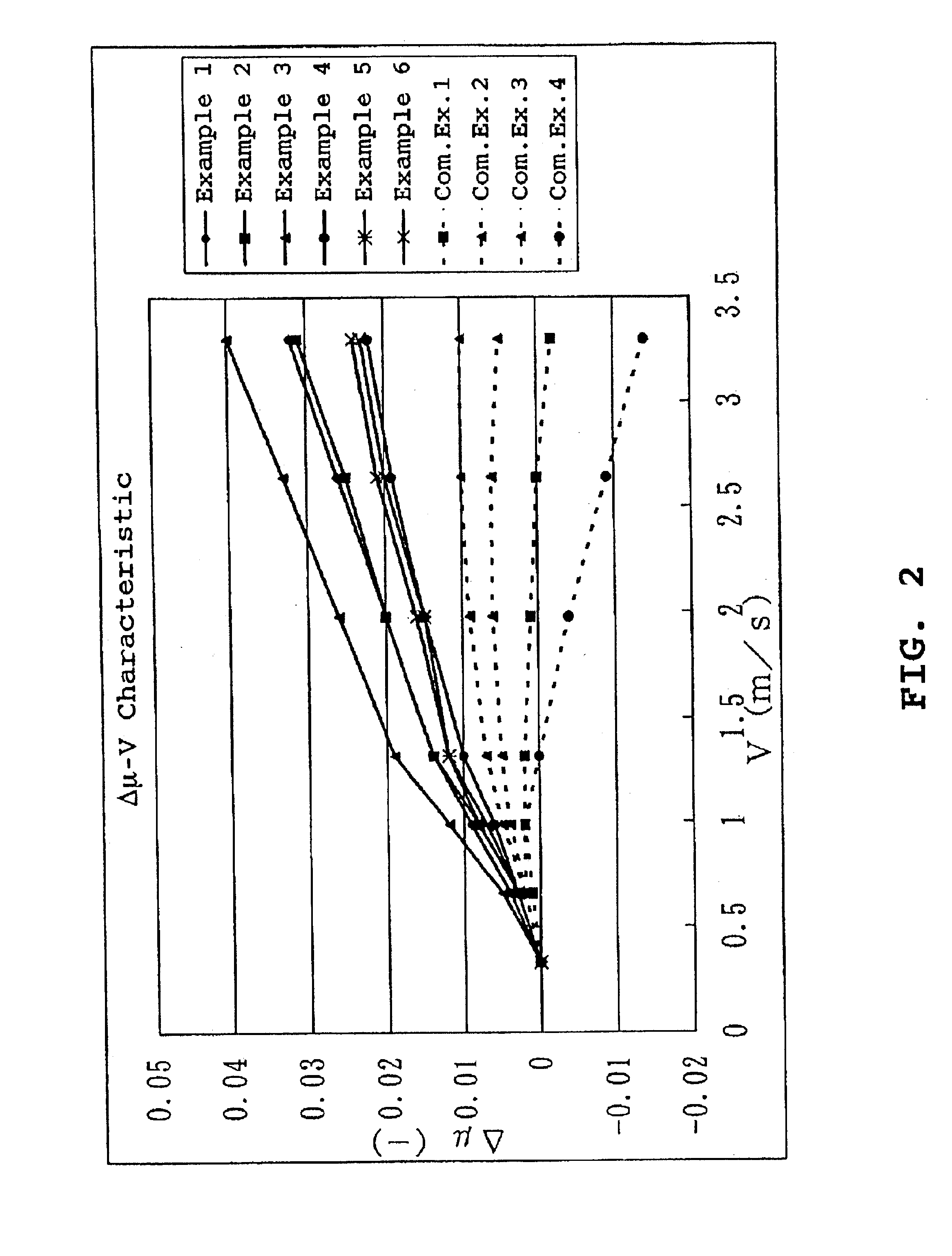Resin composition for use in manufacturing wet friction materials and wet friction material
a technology of phenolic resin and wet friction material, which is applied in the direction of friction lining, non-fibrous pulp addition, other chemical processes, etc., can solve the problems of uneven abutment of separator plate, durability of wet friction material manufactured using such an unmodified phenolic resin as a binder, and affecting the frictional properties of resin
- Summary
- Abstract
- Description
- Claims
- Application Information
AI Technical Summary
Benefits of technology
Problems solved by technology
Method used
Image
Examples
example 1
Preparation of Phenolic Resin
940 parts by weight of phenol, 895 parts by weight of 37% formalin (F / P=1.1), 20 parts by weight of ammonia water, and 10 parts by weight of 50% sodium hydroxide were put in a flask equipped with a stirrer, a reflux condenser, and a thermometer to be reacted at a temperature of 80.degree. C. for 1 hour. Thereafter, the resultant substance was subjected to dehydration in a vacuum of 110 mmHg, and then at the time when a temperature was reached to 75.degree. C., 370 parts by weight of methanol was added thereto. Then, the thus obtained substance was cooled, to thereby obtain a liquid phenolic resin containing a nonvolatile component of about 64.0 wt %, and having a weight average molecular weight of 358.
Preparation of Resin Composition for Wet Friction Materials
The liquid phenolic resin obtained in in the above was mixed with methanol and Fumed silica as a particulate filler (manufactured by TOKUYAMA Corp., with a product name of REOLOSIL and a product ...
example 2
A wet friction material of Example 2 was manufactured in the same manner as Example 1 except that a different particulate filler was used, and a different dispersing apparatus was used.
In this Example, AEROSIL 130 (which is a name of a product manufactured by Nippon Aerosil Co., and has an average particle size of a primary particle of about 16 nm, a specific surface area of about 130 m.sup.2 / g, and a silanol group density of about 2 SiOH / nm.sup.2) was used as a particulate filler, and an ultrasonic generator was used as a dispersing apparatus. It is to be noted that the median diameter of the particulate filler in the obtained resin composition for wet friction materials was 10 .mu.m.
example 3
A wet friction material of Example 3 was manufactured in the same manner as Example 1 except that a different particulate filler was used, and a different dispersing apparatus was used.
In this Example, Fumed silica (manufactured by Nippon Aerosil Co., with a product name of AEROSIL 200, and having an average particle size of a primary particle of about 12 nm, a specific surface area of about 200 m.sup.2 / g, and a silanol group density of about 3 SiOH / nm.sup.2) was used as a particulate filler, and CLEARMIX (which is a trademark of a product manufactured by ORGANO CORPORATION) was used as a dispersing apparatus. It is to be noted that the median diameter of the particulate filler in the obtained resin composition for wet friction materials was 9 .mu.m.
PUM
| Property | Measurement | Unit |
|---|---|---|
| specific surface area | aaaaa | aaaaa |
| mole ratio | aaaaa | aaaaa |
| particle size | aaaaa | aaaaa |
Abstract
Description
Claims
Application Information
 Login to View More
Login to View More - R&D
- Intellectual Property
- Life Sciences
- Materials
- Tech Scout
- Unparalleled Data Quality
- Higher Quality Content
- 60% Fewer Hallucinations
Browse by: Latest US Patents, China's latest patents, Technical Efficacy Thesaurus, Application Domain, Technology Topic, Popular Technical Reports.
© 2025 PatSnap. All rights reserved.Legal|Privacy policy|Modern Slavery Act Transparency Statement|Sitemap|About US| Contact US: help@patsnap.com



